Relationship between Disaster Management and IT Investment in Telstra
VerifiedAdded on 2023/06/07
|15
|4795
|416
AI Summary
This research paper explores the relationship between disaster management and IT investment in Telstra, the largest telecommunication company in Australia. It discusses the concept of disaster management, the need for investment in information technology, and evaluates the relationship between IT and disaster management. The paper also examines Telstra's IT investment for disaster management and its effectiveness. The research methodology used is secondary data collection and critical literature review.
Contribute Materials
Your contribution can guide someone’s learning journey. Share your
documents today.
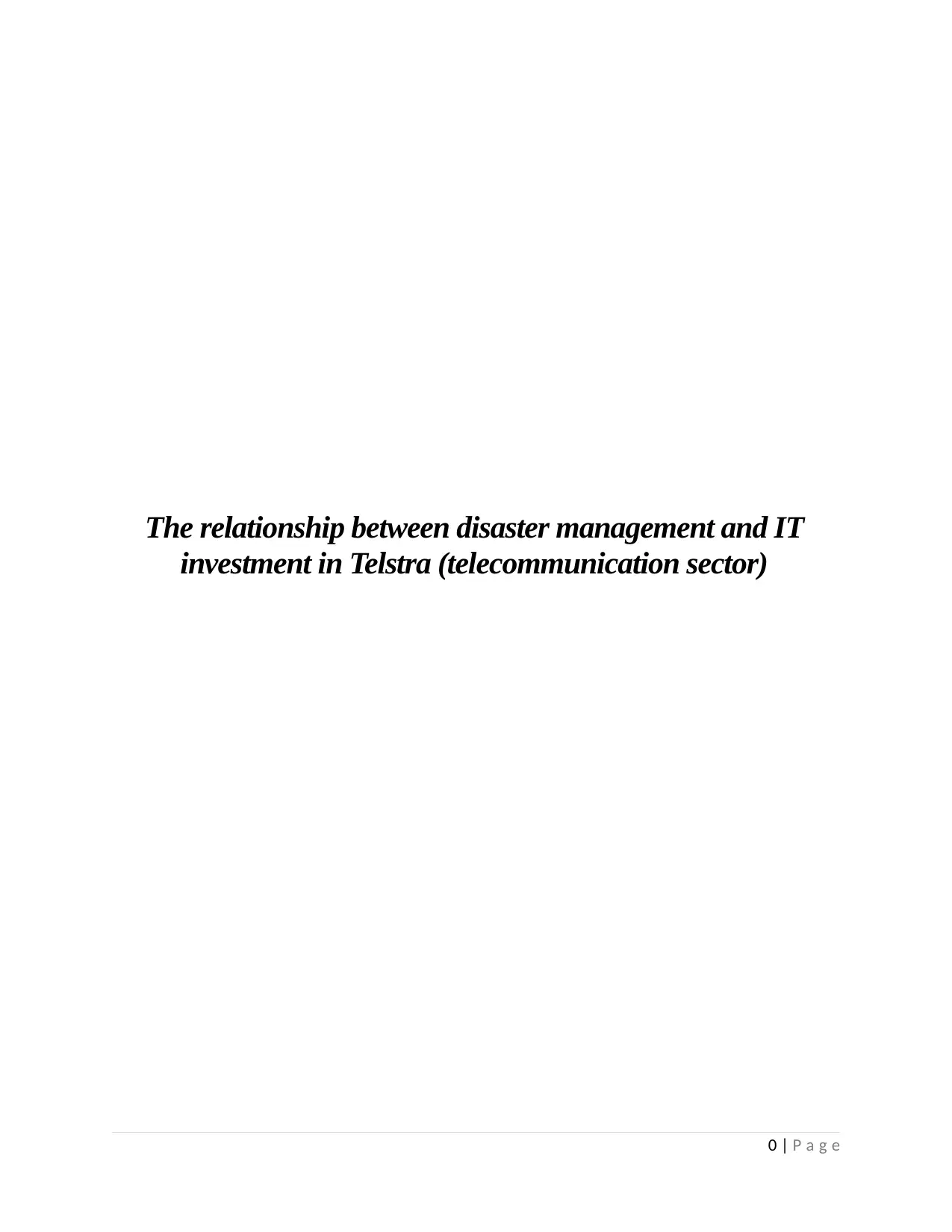
The relationship between disaster management and IT
investment in Telstra (telecommunication sector)
0 | P a g e
investment in Telstra (telecommunication sector)
0 | P a g e
Secure Best Marks with AI Grader
Need help grading? Try our AI Grader for instant feedback on your assignments.
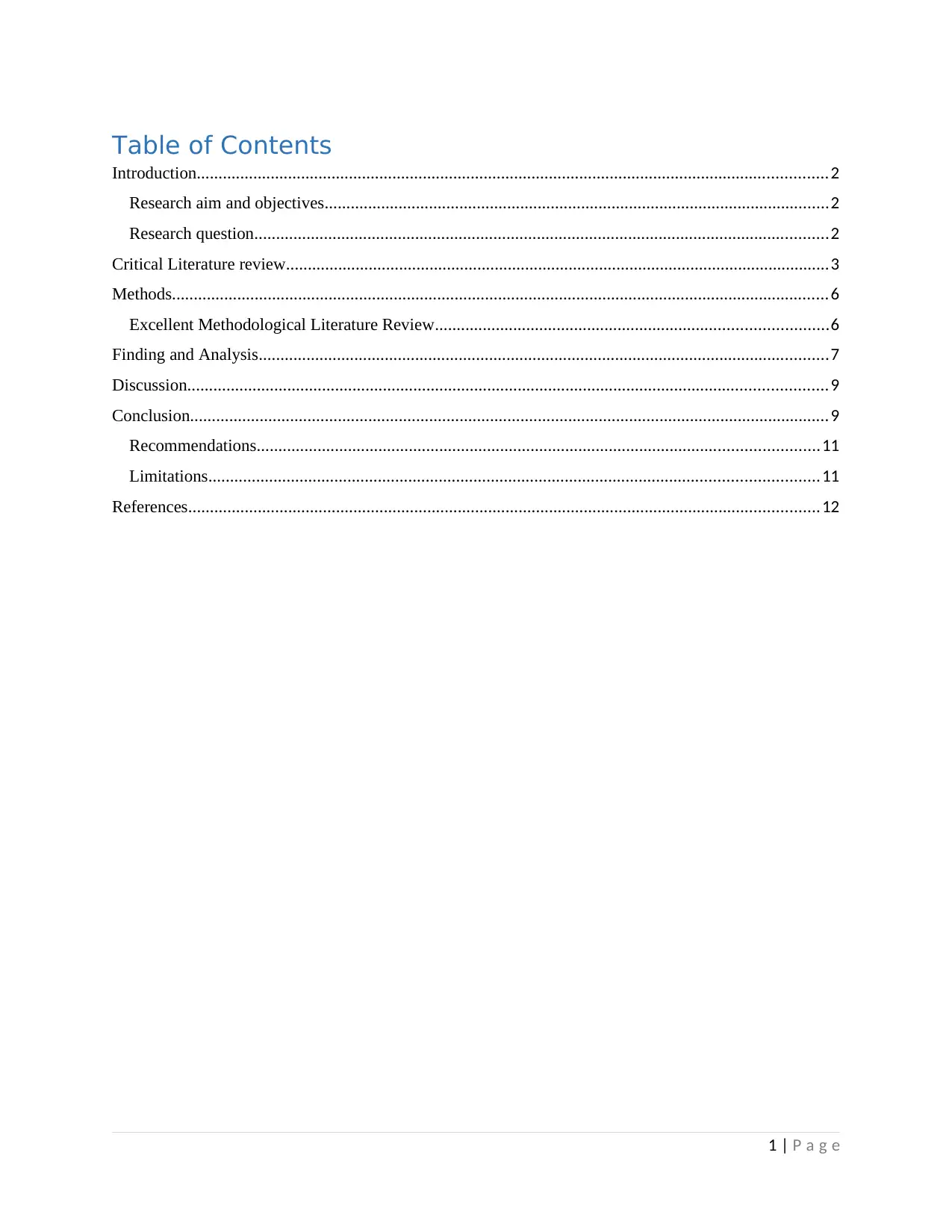
Table of Contents
Introduction.................................................................................................................................................2
Research aim and objectives....................................................................................................................2
Research question....................................................................................................................................2
Critical Literature review.............................................................................................................................3
Methods.......................................................................................................................................................6
Excellent Methodological Literature Review..........................................................................................6
Finding and Analysis...................................................................................................................................7
Discussion...................................................................................................................................................9
Conclusion...................................................................................................................................................9
Recommendations.................................................................................................................................11
Limitations............................................................................................................................................11
References.................................................................................................................................................12
1 | P a g e
Introduction.................................................................................................................................................2
Research aim and objectives....................................................................................................................2
Research question....................................................................................................................................2
Critical Literature review.............................................................................................................................3
Methods.......................................................................................................................................................6
Excellent Methodological Literature Review..........................................................................................6
Finding and Analysis...................................................................................................................................7
Discussion...................................................................................................................................................9
Conclusion...................................................................................................................................................9
Recommendations.................................................................................................................................11
Limitations............................................................................................................................................11
References.................................................................................................................................................12
1 | P a g e
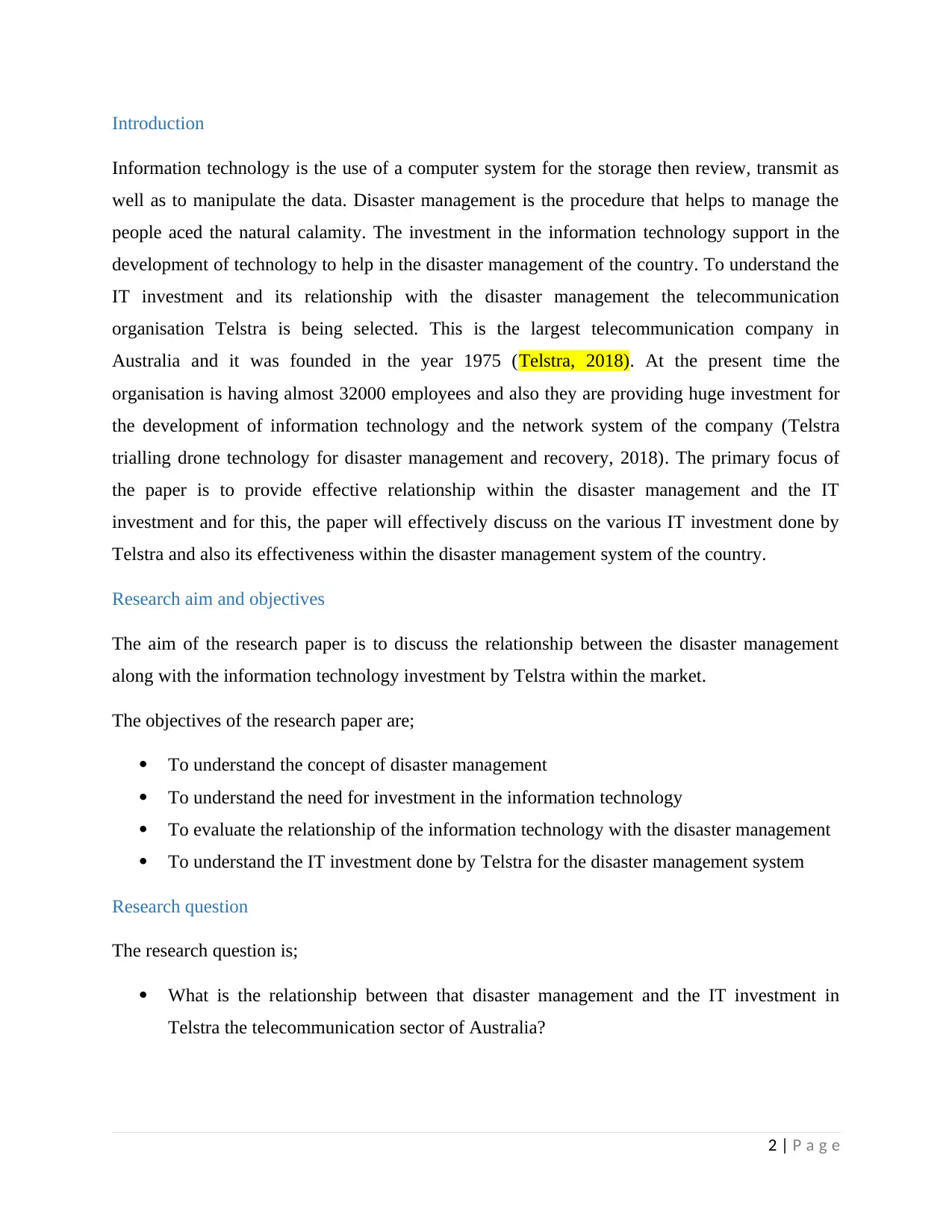
Introduction
Information technology is the use of a computer system for the storage then review, transmit as
well as to manipulate the data. Disaster management is the procedure that helps to manage the
people aced the natural calamity. The investment in the information technology support in the
development of technology to help in the disaster management of the country. To understand the
IT investment and its relationship with the disaster management the telecommunication
organisation Telstra is being selected. This is the largest telecommunication company in
Australia and it was founded in the year 1975 (Telstra, 2018). At the present time the
organisation is having almost 32000 employees and also they are providing huge investment for
the development of information technology and the network system of the company (Telstra
trialling drone technology for disaster management and recovery, 2018). The primary focus of
the paper is to provide effective relationship within the disaster management and the IT
investment and for this, the paper will effectively discuss on the various IT investment done by
Telstra and also its effectiveness within the disaster management system of the country.
Research aim and objectives
The aim of the research paper is to discuss the relationship between the disaster management
along with the information technology investment by Telstra within the market.
The objectives of the research paper are;
To understand the concept of disaster management
To understand the need for investment in the information technology
To evaluate the relationship of the information technology with the disaster management
To understand the IT investment done by Telstra for the disaster management system
Research question
The research question is;
What is the relationship between that disaster management and the IT investment in
Telstra the telecommunication sector of Australia?
2 | P a g e
Information technology is the use of a computer system for the storage then review, transmit as
well as to manipulate the data. Disaster management is the procedure that helps to manage the
people aced the natural calamity. The investment in the information technology support in the
development of technology to help in the disaster management of the country. To understand the
IT investment and its relationship with the disaster management the telecommunication
organisation Telstra is being selected. This is the largest telecommunication company in
Australia and it was founded in the year 1975 (Telstra, 2018). At the present time the
organisation is having almost 32000 employees and also they are providing huge investment for
the development of information technology and the network system of the company (Telstra
trialling drone technology for disaster management and recovery, 2018). The primary focus of
the paper is to provide effective relationship within the disaster management and the IT
investment and for this, the paper will effectively discuss on the various IT investment done by
Telstra and also its effectiveness within the disaster management system of the country.
Research aim and objectives
The aim of the research paper is to discuss the relationship between the disaster management
along with the information technology investment by Telstra within the market.
The objectives of the research paper are;
To understand the concept of disaster management
To understand the need for investment in the information technology
To evaluate the relationship of the information technology with the disaster management
To understand the IT investment done by Telstra for the disaster management system
Research question
The research question is;
What is the relationship between that disaster management and the IT investment in
Telstra the telecommunication sector of Australia?
2 | P a g e
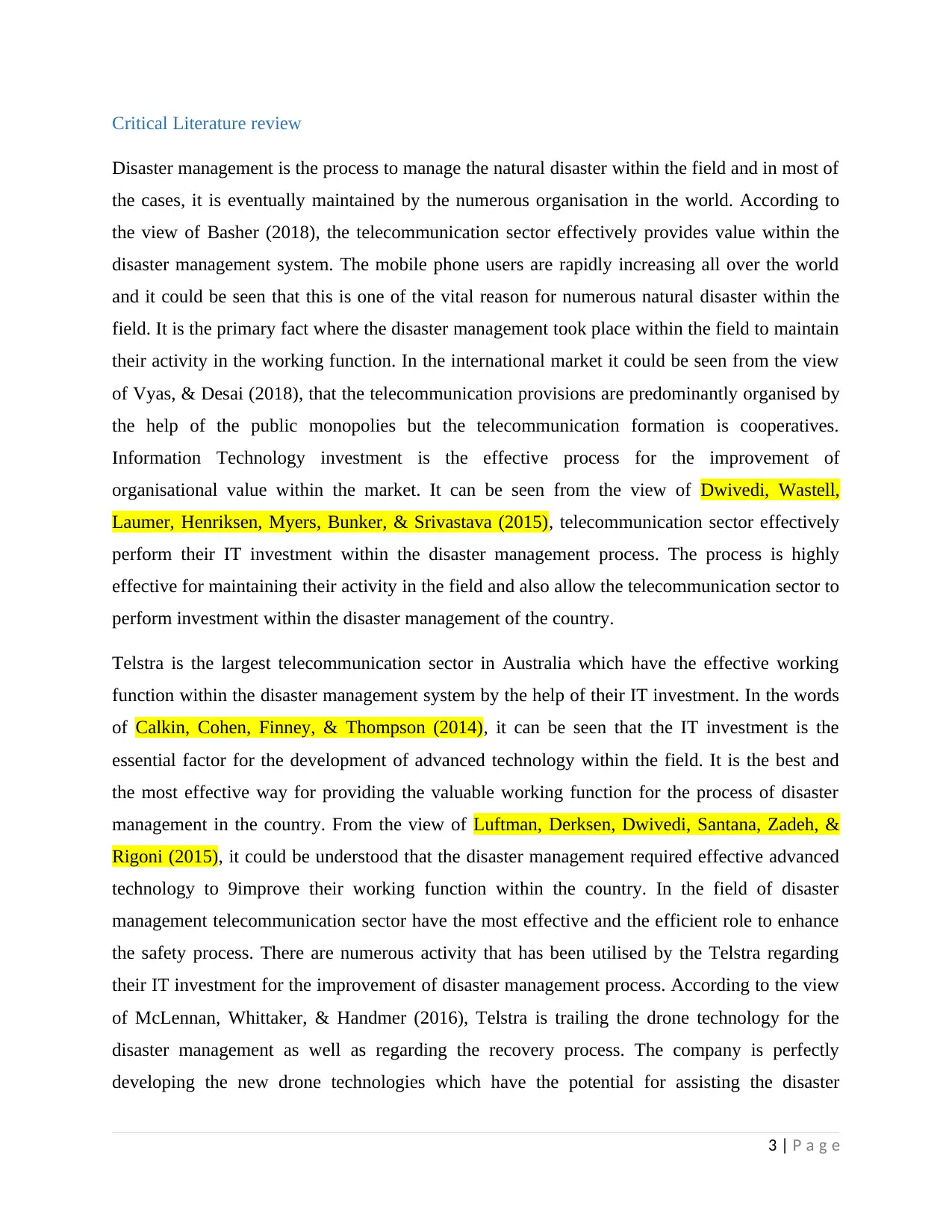
Critical Literature review
Disaster management is the process to manage the natural disaster within the field and in most of
the cases, it is eventually maintained by the numerous organisation in the world. According to
the view of Basher (2018), the telecommunication sector effectively provides value within the
disaster management system. The mobile phone users are rapidly increasing all over the world
and it could be seen that this is one of the vital reason for numerous natural disaster within the
field. It is the primary fact where the disaster management took place within the field to maintain
their activity in the working function. In the international market it could be seen from the view
of Vyas, & Desai (2018), that the telecommunication provisions are predominantly organised by
the help of the public monopolies but the telecommunication formation is cooperatives.
Information Technology investment is the effective process for the improvement of
organisational value within the market. It can be seen from the view of Dwivedi, Wastell,
Laumer, Henriksen, Myers, Bunker, & Srivastava (2015), telecommunication sector effectively
perform their IT investment within the disaster management process. The process is highly
effective for maintaining their activity in the field and also allow the telecommunication sector to
perform investment within the disaster management of the country.
Telstra is the largest telecommunication sector in Australia which have the effective working
function within the disaster management system by the help of their IT investment. In the words
of Calkin, Cohen, Finney, & Thompson (2014), it can be seen that the IT investment is the
essential factor for the development of advanced technology within the field. It is the best and
the most effective way for providing the valuable working function for the process of disaster
management in the country. From the view of Luftman, Derksen, Dwivedi, Santana, Zadeh, &
Rigoni (2015), it could be understood that the disaster management required effective advanced
technology to 9improve their working function within the country. In the field of disaster
management telecommunication sector have the most effective and the efficient role to enhance
the safety process. There are numerous activity that has been utilised by the Telstra regarding
their IT investment for the improvement of disaster management process. According to the view
of McLennan, Whittaker, & Handmer (2016), Telstra is trailing the drone technology for the
disaster management as well as regarding the recovery process. The company is perfectly
developing the new drone technologies which have the potential for assisting the disaster
3 | P a g e
Disaster management is the process to manage the natural disaster within the field and in most of
the cases, it is eventually maintained by the numerous organisation in the world. According to
the view of Basher (2018), the telecommunication sector effectively provides value within the
disaster management system. The mobile phone users are rapidly increasing all over the world
and it could be seen that this is one of the vital reason for numerous natural disaster within the
field. It is the primary fact where the disaster management took place within the field to maintain
their activity in the working function. In the international market it could be seen from the view
of Vyas, & Desai (2018), that the telecommunication provisions are predominantly organised by
the help of the public monopolies but the telecommunication formation is cooperatives.
Information Technology investment is the effective process for the improvement of
organisational value within the market. It can be seen from the view of Dwivedi, Wastell,
Laumer, Henriksen, Myers, Bunker, & Srivastava (2015), telecommunication sector effectively
perform their IT investment within the disaster management process. The process is highly
effective for maintaining their activity in the field and also allow the telecommunication sector to
perform investment within the disaster management of the country.
Telstra is the largest telecommunication sector in Australia which have the effective working
function within the disaster management system by the help of their IT investment. In the words
of Calkin, Cohen, Finney, & Thompson (2014), it can be seen that the IT investment is the
essential factor for the development of advanced technology within the field. It is the best and
the most effective way for providing the valuable working function for the process of disaster
management in the country. From the view of Luftman, Derksen, Dwivedi, Santana, Zadeh, &
Rigoni (2015), it could be understood that the disaster management required effective advanced
technology to 9improve their working function within the country. In the field of disaster
management telecommunication sector have the most effective and the efficient role to enhance
the safety process. There are numerous activity that has been utilised by the Telstra regarding
their IT investment for the improvement of disaster management process. According to the view
of McLennan, Whittaker, & Handmer (2016), Telstra is trailing the drone technology for the
disaster management as well as regarding the recovery process. The company is perfectly
developing the new drone technologies which have the potential for assisting the disaster
3 | P a g e
Secure Best Marks with AI Grader
Need help grading? Try our AI Grader for instant feedback on your assignments.
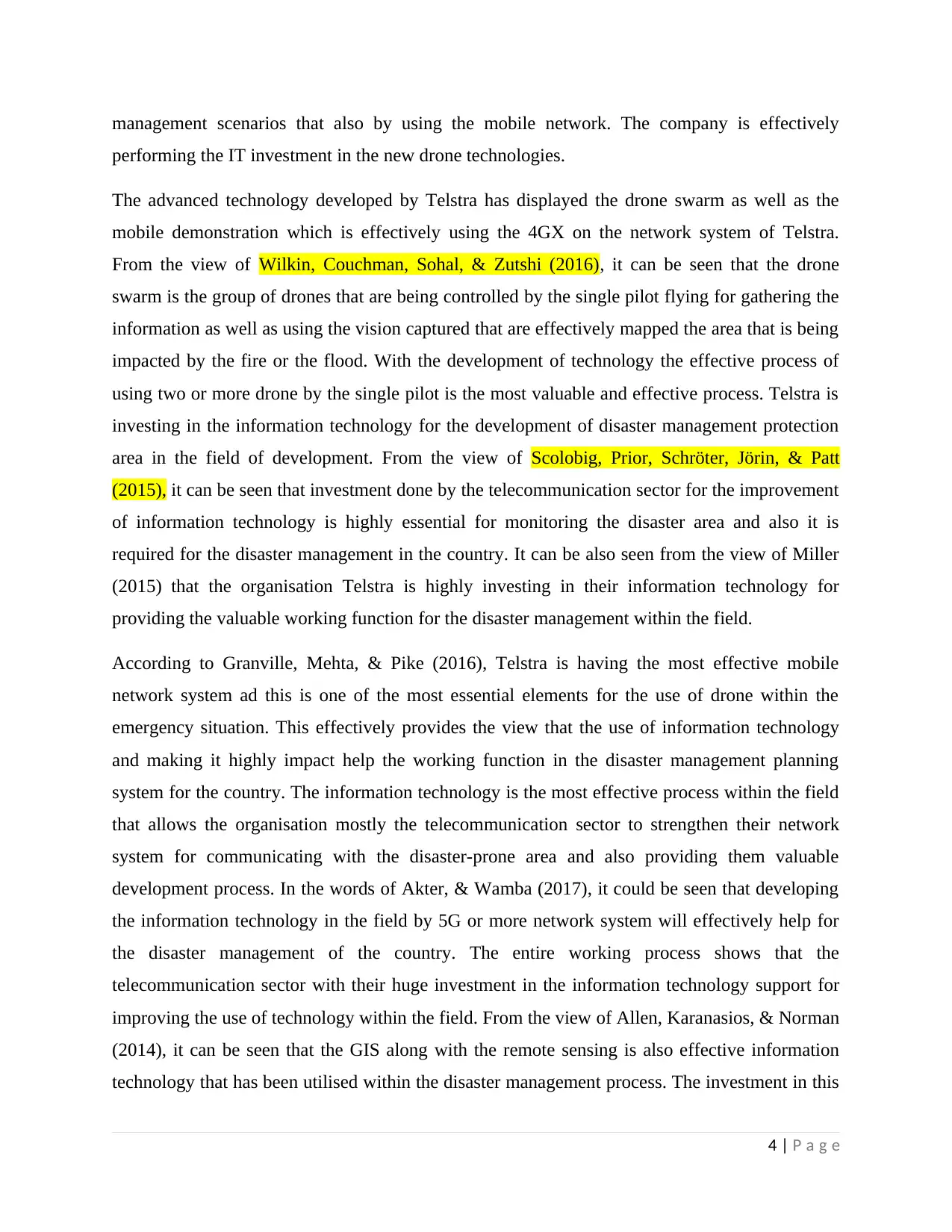
management scenarios that also by using the mobile network. The company is effectively
performing the IT investment in the new drone technologies.
The advanced technology developed by Telstra has displayed the drone swarm as well as the
mobile demonstration which is effectively using the 4GX on the network system of Telstra.
From the view of Wilkin, Couchman, Sohal, & Zutshi (2016), it can be seen that the drone
swarm is the group of drones that are being controlled by the single pilot flying for gathering the
information as well as using the vision captured that are effectively mapped the area that is being
impacted by the fire or the flood. With the development of technology the effective process of
using two or more drone by the single pilot is the most valuable and effective process. Telstra is
investing in the information technology for the development of disaster management protection
area in the field of development. From the view of Scolobig, Prior, Schröter, Jörin, & Patt
(2015), it can be seen that investment done by the telecommunication sector for the improvement
of information technology is highly essential for monitoring the disaster area and also it is
required for the disaster management in the country. It can be also seen from the view of Miller
(2015) that the organisation Telstra is highly investing in their information technology for
providing the valuable working function for the disaster management within the field.
According to Granville, Mehta, & Pike (2016), Telstra is having the most effective mobile
network system ad this is one of the most essential elements for the use of drone within the
emergency situation. This effectively provides the view that the use of information technology
and making it highly impact help the working function in the disaster management planning
system for the country. The information technology is the most effective process within the field
that allows the organisation mostly the telecommunication sector to strengthen their network
system for communicating with the disaster-prone area and also providing them valuable
development process. In the words of Akter, & Wamba (2017), it could be seen that developing
the information technology in the field by 5G or more network system will effectively help for
the disaster management of the country. The entire working process shows that the
telecommunication sector with their huge investment in the information technology support for
improving the use of technology within the field. From the view of Allen, Karanasios, & Norman
(2014), it can be seen that the GIS along with the remote sensing is also effective information
technology that has been utilised within the disaster management process. The investment in this
4 | P a g e
performing the IT investment in the new drone technologies.
The advanced technology developed by Telstra has displayed the drone swarm as well as the
mobile demonstration which is effectively using the 4GX on the network system of Telstra.
From the view of Wilkin, Couchman, Sohal, & Zutshi (2016), it can be seen that the drone
swarm is the group of drones that are being controlled by the single pilot flying for gathering the
information as well as using the vision captured that are effectively mapped the area that is being
impacted by the fire or the flood. With the development of technology the effective process of
using two or more drone by the single pilot is the most valuable and effective process. Telstra is
investing in the information technology for the development of disaster management protection
area in the field of development. From the view of Scolobig, Prior, Schröter, Jörin, & Patt
(2015), it can be seen that investment done by the telecommunication sector for the improvement
of information technology is highly essential for monitoring the disaster area and also it is
required for the disaster management in the country. It can be also seen from the view of Miller
(2015) that the organisation Telstra is highly investing in their information technology for
providing the valuable working function for the disaster management within the field.
According to Granville, Mehta, & Pike (2016), Telstra is having the most effective mobile
network system ad this is one of the most essential elements for the use of drone within the
emergency situation. This effectively provides the view that the use of information technology
and making it highly impact help the working function in the disaster management planning
system for the country. The information technology is the most effective process within the field
that allows the organisation mostly the telecommunication sector to strengthen their network
system for communicating with the disaster-prone area and also providing them valuable
development process. In the words of Akter, & Wamba (2017), it could be seen that developing
the information technology in the field by 5G or more network system will effectively help for
the disaster management of the country. The entire working process shows that the
telecommunication sector with their huge investment in the information technology support for
improving the use of technology within the field. From the view of Allen, Karanasios, & Norman
(2014), it can be seen that the GIS along with the remote sensing is also effective information
technology that has been utilised within the disaster management process. The investment in this
4 | P a g e
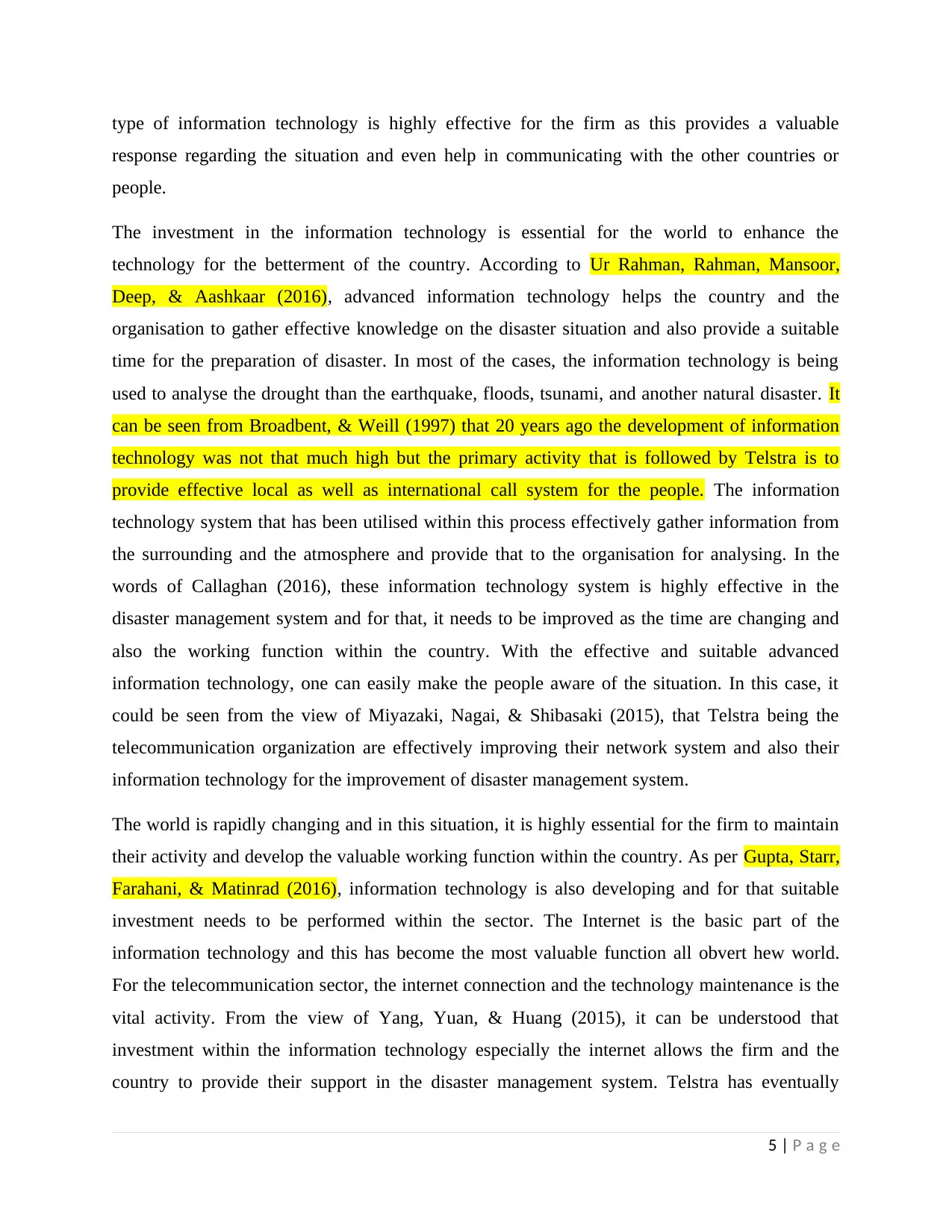
type of information technology is highly effective for the firm as this provides a valuable
response regarding the situation and even help in communicating with the other countries or
people.
The investment in the information technology is essential for the world to enhance the
technology for the betterment of the country. According to Ur Rahman, Rahman, Mansoor,
Deep, & Aashkaar (2016), advanced information technology helps the country and the
organisation to gather effective knowledge on the disaster situation and also provide a suitable
time for the preparation of disaster. In most of the cases, the information technology is being
used to analyse the drought than the earthquake, floods, tsunami, and another natural disaster. It
can be seen from Broadbent, & Weill (1997) that 20 years ago the development of information
technology was not that much high but the primary activity that is followed by Telstra is to
provide effective local as well as international call system for the people. The information
technology system that has been utilised within this process effectively gather information from
the surrounding and the atmosphere and provide that to the organisation for analysing. In the
words of Callaghan (2016), these information technology system is highly effective in the
disaster management system and for that, it needs to be improved as the time are changing and
also the working function within the country. With the effective and suitable advanced
information technology, one can easily make the people aware of the situation. In this case, it
could be seen from the view of Miyazaki, Nagai, & Shibasaki (2015), that Telstra being the
telecommunication organization are effectively improving their network system and also their
information technology for the improvement of disaster management system.
The world is rapidly changing and in this situation, it is highly essential for the firm to maintain
their activity and develop the valuable working function within the country. As per Gupta, Starr,
Farahani, & Matinrad (2016), information technology is also developing and for that suitable
investment needs to be performed within the sector. The Internet is the basic part of the
information technology and this has become the most valuable function all obvert hew world.
For the telecommunication sector, the internet connection and the technology maintenance is the
vital activity. From the view of Yang, Yuan, & Huang (2015), it can be understood that
investment within the information technology especially the internet allows the firm and the
country to provide their support in the disaster management system. Telstra has eventually
5 | P a g e
response regarding the situation and even help in communicating with the other countries or
people.
The investment in the information technology is essential for the world to enhance the
technology for the betterment of the country. According to Ur Rahman, Rahman, Mansoor,
Deep, & Aashkaar (2016), advanced information technology helps the country and the
organisation to gather effective knowledge on the disaster situation and also provide a suitable
time for the preparation of disaster. In most of the cases, the information technology is being
used to analyse the drought than the earthquake, floods, tsunami, and another natural disaster. It
can be seen from Broadbent, & Weill (1997) that 20 years ago the development of information
technology was not that much high but the primary activity that is followed by Telstra is to
provide effective local as well as international call system for the people. The information
technology system that has been utilised within this process effectively gather information from
the surrounding and the atmosphere and provide that to the organisation for analysing. In the
words of Callaghan (2016), these information technology system is highly effective in the
disaster management system and for that, it needs to be improved as the time are changing and
also the working function within the country. With the effective and suitable advanced
information technology, one can easily make the people aware of the situation. In this case, it
could be seen from the view of Miyazaki, Nagai, & Shibasaki (2015), that Telstra being the
telecommunication organization are effectively improving their network system and also their
information technology for the improvement of disaster management system.
The world is rapidly changing and in this situation, it is highly essential for the firm to maintain
their activity and develop the valuable working function within the country. As per Gupta, Starr,
Farahani, & Matinrad (2016), information technology is also developing and for that suitable
investment needs to be performed within the sector. The Internet is the basic part of the
information technology and this has become the most valuable function all obvert hew world.
For the telecommunication sector, the internet connection and the technology maintenance is the
vital activity. From the view of Yang, Yuan, & Huang (2015), it can be understood that
investment within the information technology especially the internet allows the firm and the
country to provide their support in the disaster management system. Telstra has eventually
5 | P a g e
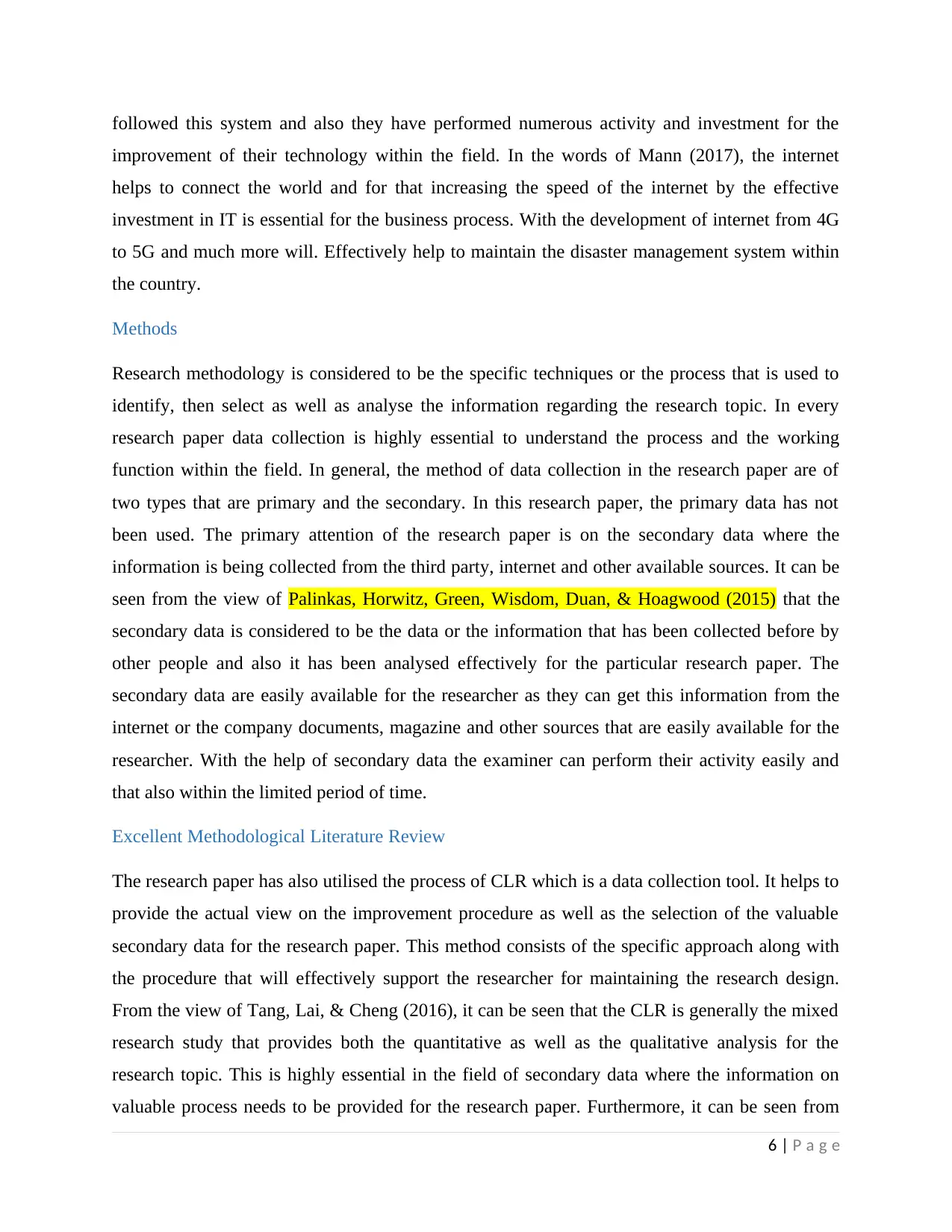
followed this system and also they have performed numerous activity and investment for the
improvement of their technology within the field. In the words of Mann (2017), the internet
helps to connect the world and for that increasing the speed of the internet by the effective
investment in IT is essential for the business process. With the development of internet from 4G
to 5G and much more will. Effectively help to maintain the disaster management system within
the country.
Methods
Research methodology is considered to be the specific techniques or the process that is used to
identify, then select as well as analyse the information regarding the research topic. In every
research paper data collection is highly essential to understand the process and the working
function within the field. In general, the method of data collection in the research paper are of
two types that are primary and the secondary. In this research paper, the primary data has not
been used. The primary attention of the research paper is on the secondary data where the
information is being collected from the third party, internet and other available sources. It can be
seen from the view of Palinkas, Horwitz, Green, Wisdom, Duan, & Hoagwood (2015) that the
secondary data is considered to be the data or the information that has been collected before by
other people and also it has been analysed effectively for the particular research paper. The
secondary data are easily available for the researcher as they can get this information from the
internet or the company documents, magazine and other sources that are easily available for the
researcher. With the help of secondary data the examiner can perform their activity easily and
that also within the limited period of time.
Excellent Methodological Literature Review
The research paper has also utilised the process of CLR which is a data collection tool. It helps to
provide the actual view on the improvement procedure as well as the selection of the valuable
secondary data for the research paper. This method consists of the specific approach along with
the procedure that will effectively support the researcher for maintaining the research design.
From the view of Tang, Lai, & Cheng (2016), it can be seen that the CLR is generally the mixed
research study that provides both the quantitative as well as the qualitative analysis for the
research topic. This is highly essential in the field of secondary data where the information on
valuable process needs to be provided for the research paper. Furthermore, it can be seen from
6 | P a g e
improvement of their technology within the field. In the words of Mann (2017), the internet
helps to connect the world and for that increasing the speed of the internet by the effective
investment in IT is essential for the business process. With the development of internet from 4G
to 5G and much more will. Effectively help to maintain the disaster management system within
the country.
Methods
Research methodology is considered to be the specific techniques or the process that is used to
identify, then select as well as analyse the information regarding the research topic. In every
research paper data collection is highly essential to understand the process and the working
function within the field. In general, the method of data collection in the research paper are of
two types that are primary and the secondary. In this research paper, the primary data has not
been used. The primary attention of the research paper is on the secondary data where the
information is being collected from the third party, internet and other available sources. It can be
seen from the view of Palinkas, Horwitz, Green, Wisdom, Duan, & Hoagwood (2015) that the
secondary data is considered to be the data or the information that has been collected before by
other people and also it has been analysed effectively for the particular research paper. The
secondary data are easily available for the researcher as they can get this information from the
internet or the company documents, magazine and other sources that are easily available for the
researcher. With the help of secondary data the examiner can perform their activity easily and
that also within the limited period of time.
Excellent Methodological Literature Review
The research paper has also utilised the process of CLR which is a data collection tool. It helps to
provide the actual view on the improvement procedure as well as the selection of the valuable
secondary data for the research paper. This method consists of the specific approach along with
the procedure that will effectively support the researcher for maintaining the research design.
From the view of Tang, Lai, & Cheng (2016), it can be seen that the CLR is generally the mixed
research study that provides both the quantitative as well as the qualitative analysis for the
research topic. This is highly essential in the field of secondary data where the information on
valuable process needs to be provided for the research paper. Furthermore, it can be seen from
6 | P a g e
Paraphrase This Document
Need a fresh take? Get an instant paraphrase of this document with our AI Paraphraser
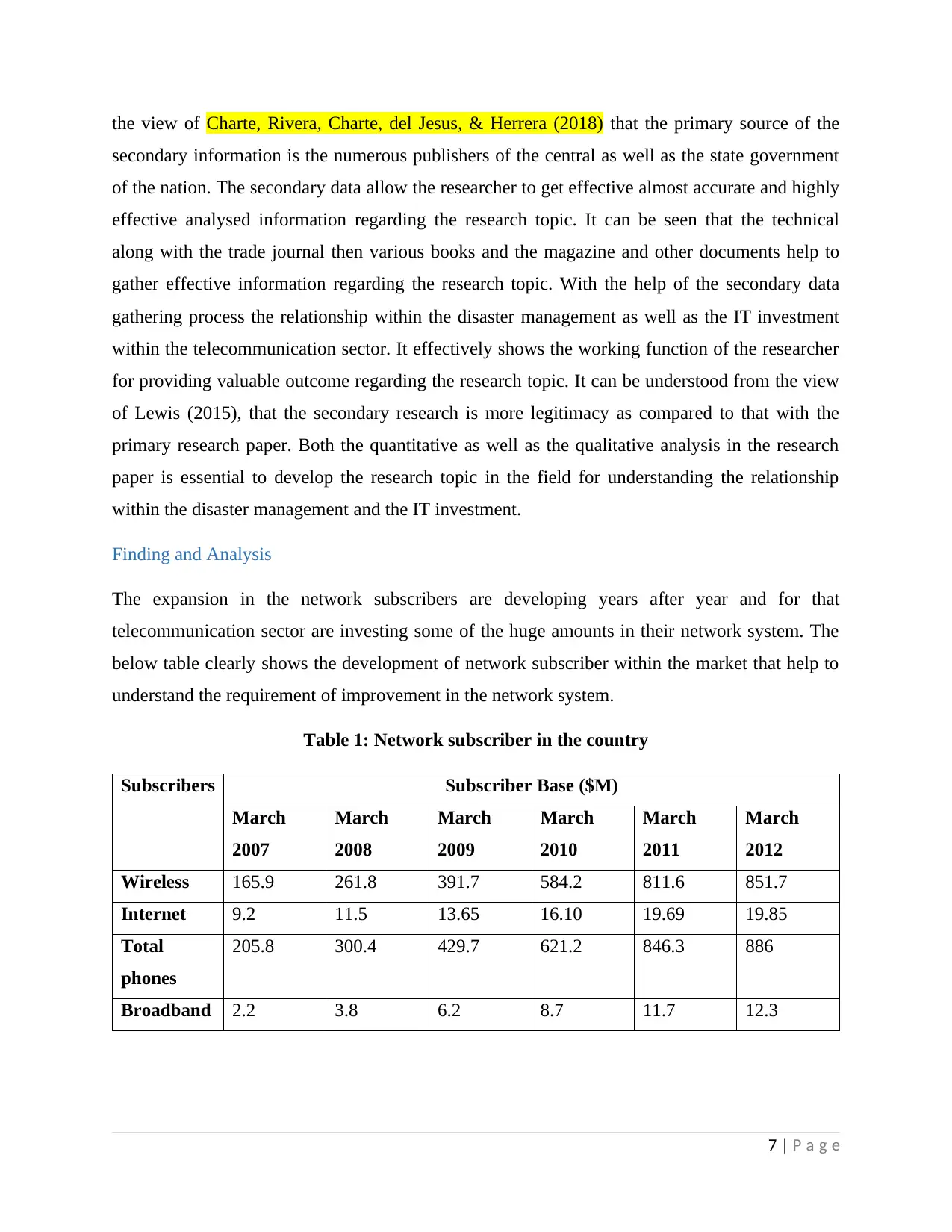
the view of Charte, Rivera, Charte, del Jesus, & Herrera (2018) that the primary source of the
secondary information is the numerous publishers of the central as well as the state government
of the nation. The secondary data allow the researcher to get effective almost accurate and highly
effective analysed information regarding the research topic. It can be seen that the technical
along with the trade journal then various books and the magazine and other documents help to
gather effective information regarding the research topic. With the help of the secondary data
gathering process the relationship within the disaster management as well as the IT investment
within the telecommunication sector. It effectively shows the working function of the researcher
for providing valuable outcome regarding the research topic. It can be understood from the view
of Lewis (2015), that the secondary research is more legitimacy as compared to that with the
primary research paper. Both the quantitative as well as the qualitative analysis in the research
paper is essential to develop the research topic in the field for understanding the relationship
within the disaster management and the IT investment.
Finding and Analysis
The expansion in the network subscribers are developing years after year and for that
telecommunication sector are investing some of the huge amounts in their network system. The
below table clearly shows the development of network subscriber within the market that help to
understand the requirement of improvement in the network system.
Table 1: Network subscriber in the country
Subscribers Subscriber Base ($M)
March
2007
March
2008
March
2009
March
2010
March
2011
March
2012
Wireless 165.9 261.8 391.7 584.2 811.6 851.7
Internet 9.2 11.5 13.65 16.10 19.69 19.85
Total
phones
205.8 300.4 429.7 621.2 846.3 886
Broadband 2.2 3.8 6.2 8.7 11.7 12.3
7 | P a g e
secondary information is the numerous publishers of the central as well as the state government
of the nation. The secondary data allow the researcher to get effective almost accurate and highly
effective analysed information regarding the research topic. It can be seen that the technical
along with the trade journal then various books and the magazine and other documents help to
gather effective information regarding the research topic. With the help of the secondary data
gathering process the relationship within the disaster management as well as the IT investment
within the telecommunication sector. It effectively shows the working function of the researcher
for providing valuable outcome regarding the research topic. It can be understood from the view
of Lewis (2015), that the secondary research is more legitimacy as compared to that with the
primary research paper. Both the quantitative as well as the qualitative analysis in the research
paper is essential to develop the research topic in the field for understanding the relationship
within the disaster management and the IT investment.
Finding and Analysis
The expansion in the network subscribers are developing years after year and for that
telecommunication sector are investing some of the huge amounts in their network system. The
below table clearly shows the development of network subscriber within the market that help to
understand the requirement of improvement in the network system.
Table 1: Network subscriber in the country
Subscribers Subscriber Base ($M)
March
2007
March
2008
March
2009
March
2010
March
2011
March
2012
Wireless 165.9 261.8 391.7 584.2 811.6 851.7
Internet 9.2 11.5 13.65 16.10 19.69 19.85
Total
phones
205.8 300.4 429.7 621.2 846.3 886
Broadband 2.2 3.8 6.2 8.7 11.7 12.3
7 | P a g e
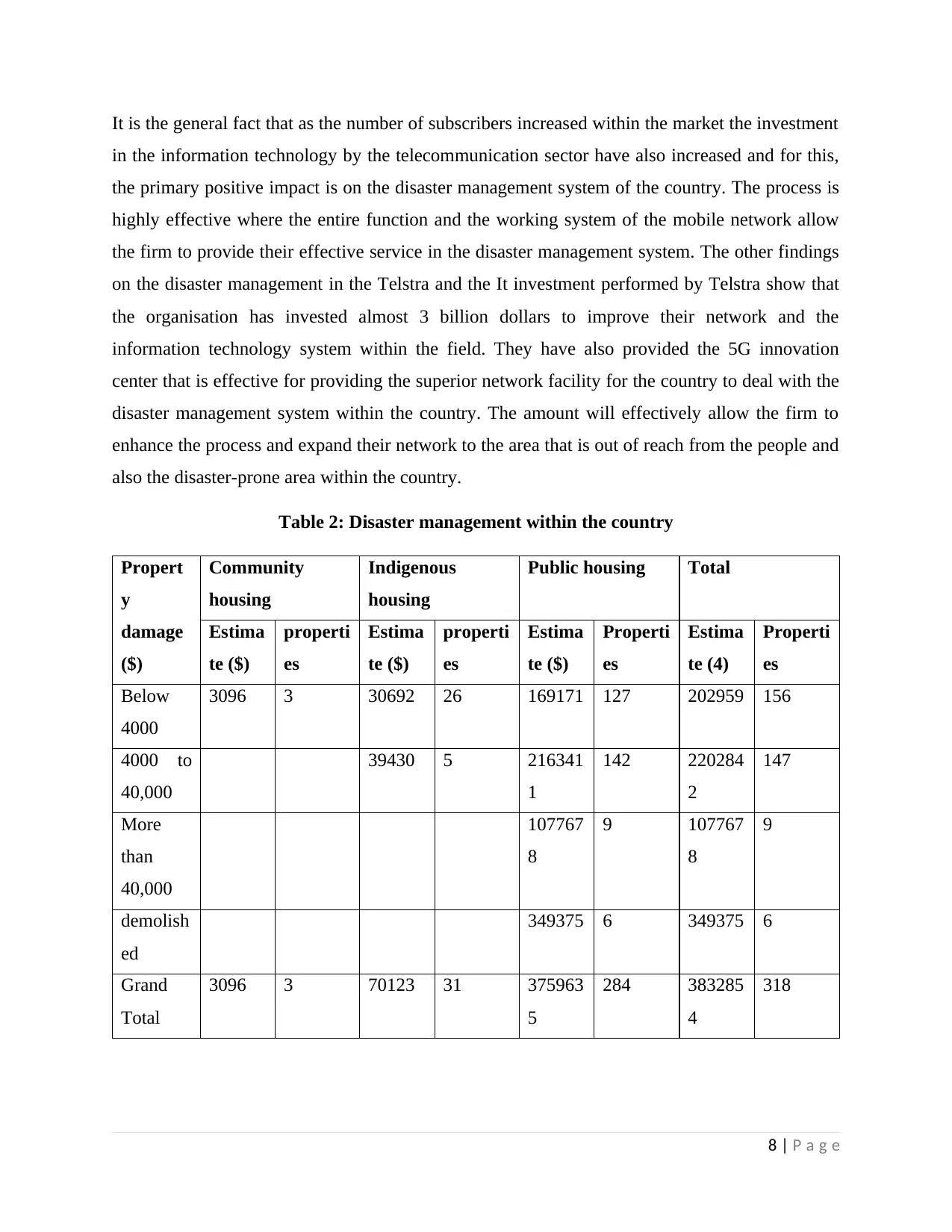
It is the general fact that as the number of subscribers increased within the market the investment
in the information technology by the telecommunication sector have also increased and for this,
the primary positive impact is on the disaster management system of the country. The process is
highly effective where the entire function and the working system of the mobile network allow
the firm to provide their effective service in the disaster management system. The other findings
on the disaster management in the Telstra and the It investment performed by Telstra show that
the organisation has invested almost 3 billion dollars to improve their network and the
information technology system within the field. They have also provided the 5G innovation
center that is effective for providing the superior network facility for the country to deal with the
disaster management system within the country. The amount will effectively allow the firm to
enhance the process and expand their network to the area that is out of reach from the people and
also the disaster-prone area within the country.
Table 2: Disaster management within the country
Propert
y
damage
($)
Community
housing
Indigenous
housing
Public housing Total
Estima
te ($)
properti
es
Estima
te ($)
properti
es
Estima
te ($)
Properti
es
Estima
te (4)
Properti
es
Below
4000
3096 3 30692 26 169171 127 202959 156
4000 to
40,000
39430 5 216341
1
142 220284
2
147
More
than
40,000
107767
8
9 107767
8
9
demolish
ed
349375 6 349375 6
Grand
Total
3096 3 70123 31 375963
5
284 383285
4
318
8 | P a g e
in the information technology by the telecommunication sector have also increased and for this,
the primary positive impact is on the disaster management system of the country. The process is
highly effective where the entire function and the working system of the mobile network allow
the firm to provide their effective service in the disaster management system. The other findings
on the disaster management in the Telstra and the It investment performed by Telstra show that
the organisation has invested almost 3 billion dollars to improve their network and the
information technology system within the field. They have also provided the 5G innovation
center that is effective for providing the superior network facility for the country to deal with the
disaster management system within the country. The amount will effectively allow the firm to
enhance the process and expand their network to the area that is out of reach from the people and
also the disaster-prone area within the country.
Table 2: Disaster management within the country
Propert
y
damage
($)
Community
housing
Indigenous
housing
Public housing Total
Estima
te ($)
properti
es
Estima
te ($)
properti
es
Estima
te ($)
Properti
es
Estima
te (4)
Properti
es
Below
4000
3096 3 30692 26 169171 127 202959 156
4000 to
40,000
39430 5 216341
1
142 220284
2
147
More
than
40,000
107767
8
9 107767
8
9
demolish
ed
349375 6 349375 6
Grand
Total
3096 3 70123 31 375963
5
284 383285
4
318
8 | P a g e
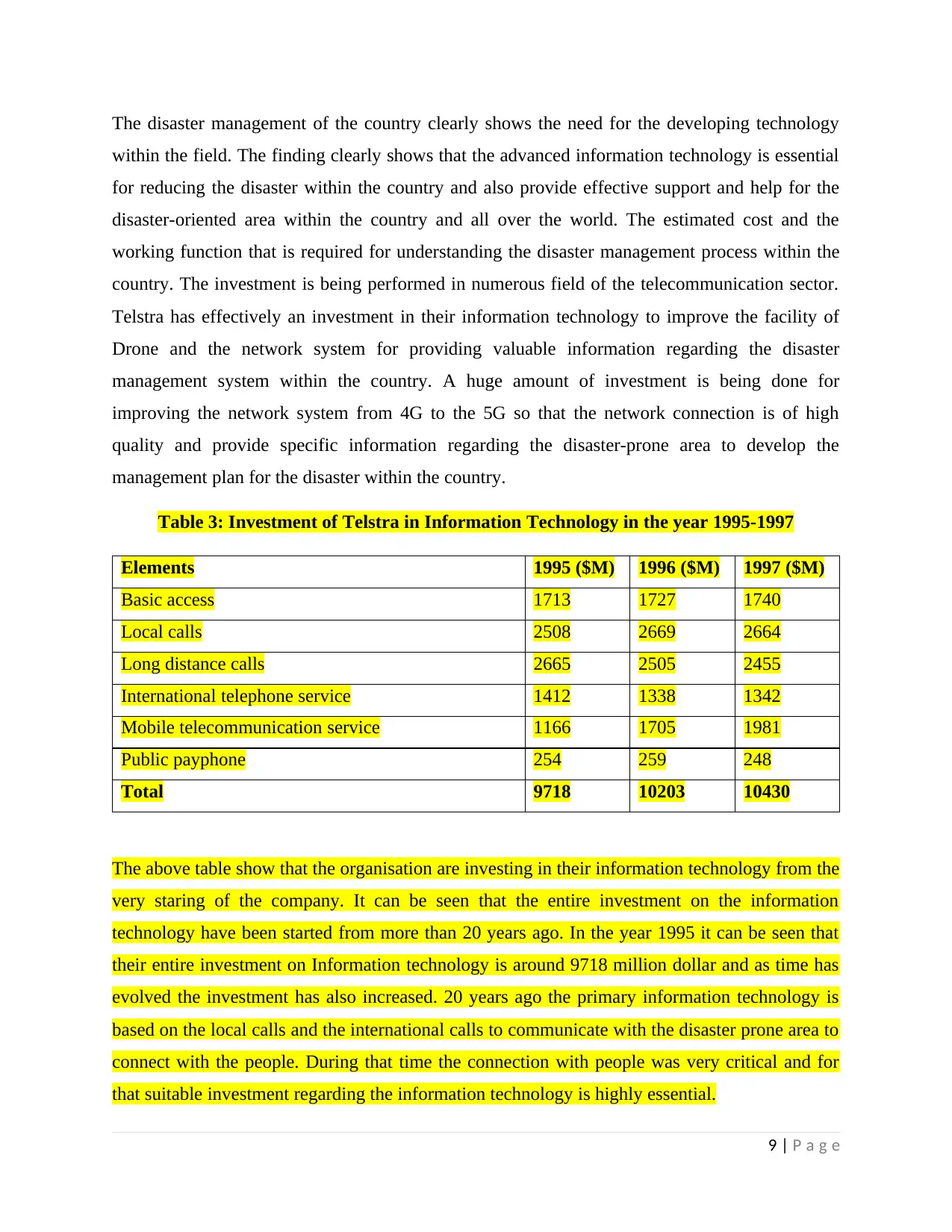
The disaster management of the country clearly shows the need for the developing technology
within the field. The finding clearly shows that the advanced information technology is essential
for reducing the disaster within the country and also provide effective support and help for the
disaster-oriented area within the country and all over the world. The estimated cost and the
working function that is required for understanding the disaster management process within the
country. The investment is being performed in numerous field of the telecommunication sector.
Telstra has effectively an investment in their information technology to improve the facility of
Drone and the network system for providing valuable information regarding the disaster
management system within the country. A huge amount of investment is being done for
improving the network system from 4G to the 5G so that the network connection is of high
quality and provide specific information regarding the disaster-prone area to develop the
management plan for the disaster within the country.
Table 3: Investment of Telstra in Information Technology in the year 1995-1997
Elements 1995 ($M) 1996 ($M) 1997 ($M)
Basic access 1713 1727 1740
Local calls 2508 2669 2664
Long distance calls 2665 2505 2455
International telephone service 1412 1338 1342
Mobile telecommunication service 1166 1705 1981
Public payphone 254 259 248
Total 9718 10203 10430
The above table show that the organisation are investing in their information technology from the
very staring of the company. It can be seen that the entire investment on the information
technology have been started from more than 20 years ago. In the year 1995 it can be seen that
their entire investment on Information technology is around 9718 million dollar and as time has
evolved the investment has also increased. 20 years ago the primary information technology is
based on the local calls and the international calls to communicate with the disaster prone area to
connect with the people. During that time the connection with people was very critical and for
that suitable investment regarding the information technology is highly essential.
9 | P a g e
within the field. The finding clearly shows that the advanced information technology is essential
for reducing the disaster within the country and also provide effective support and help for the
disaster-oriented area within the country and all over the world. The estimated cost and the
working function that is required for understanding the disaster management process within the
country. The investment is being performed in numerous field of the telecommunication sector.
Telstra has effectively an investment in their information technology to improve the facility of
Drone and the network system for providing valuable information regarding the disaster
management system within the country. A huge amount of investment is being done for
improving the network system from 4G to the 5G so that the network connection is of high
quality and provide specific information regarding the disaster-prone area to develop the
management plan for the disaster within the country.
Table 3: Investment of Telstra in Information Technology in the year 1995-1997
Elements 1995 ($M) 1996 ($M) 1997 ($M)
Basic access 1713 1727 1740
Local calls 2508 2669 2664
Long distance calls 2665 2505 2455
International telephone service 1412 1338 1342
Mobile telecommunication service 1166 1705 1981
Public payphone 254 259 248
Total 9718 10203 10430
The above table show that the organisation are investing in their information technology from the
very staring of the company. It can be seen that the entire investment on the information
technology have been started from more than 20 years ago. In the year 1995 it can be seen that
their entire investment on Information technology is around 9718 million dollar and as time has
evolved the investment has also increased. 20 years ago the primary information technology is
based on the local calls and the international calls to communicate with the disaster prone area to
connect with the people. During that time the connection with people was very critical and for
that suitable investment regarding the information technology is highly essential.
9 | P a g e
Secure Best Marks with AI Grader
Need help grading? Try our AI Grader for instant feedback on your assignments.
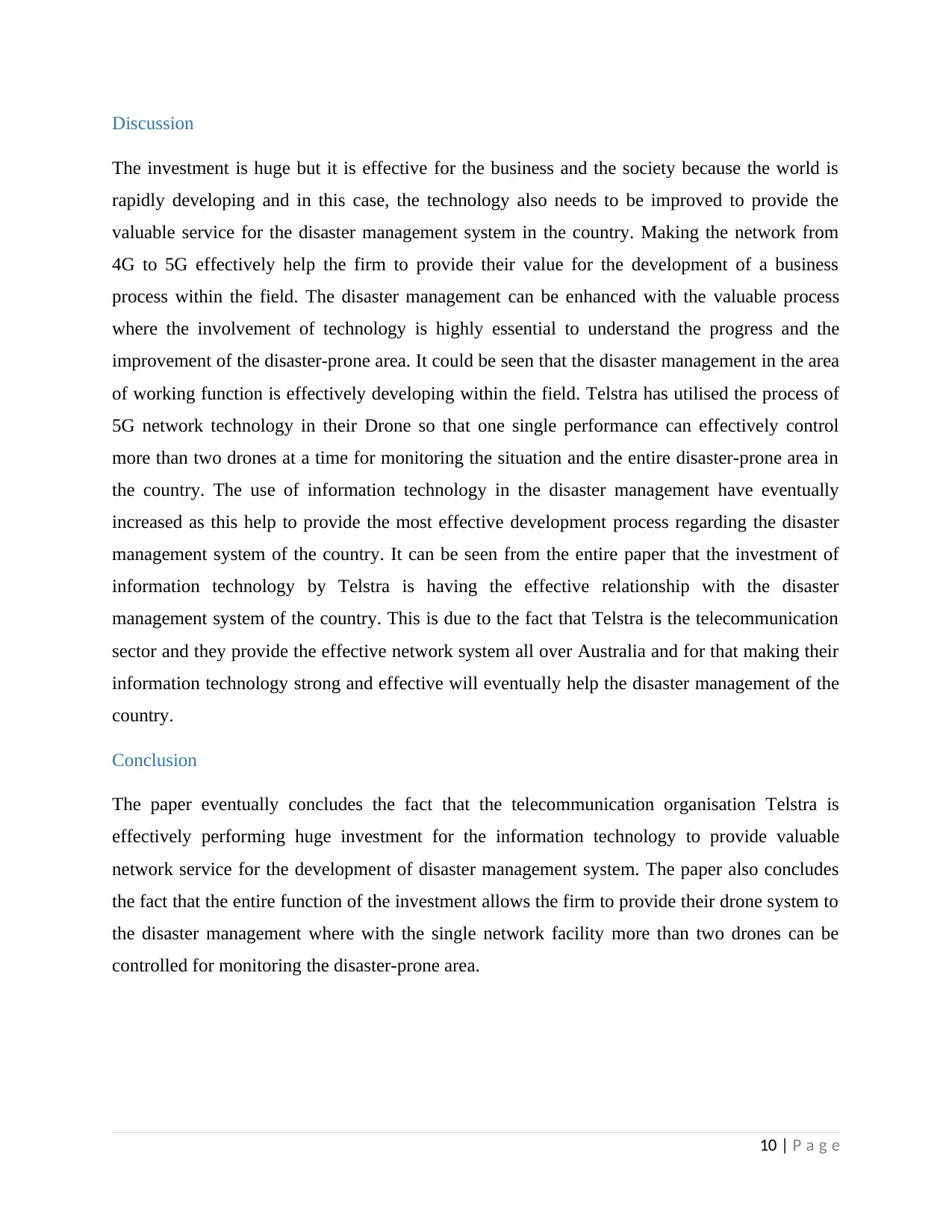
Discussion
The investment is huge but it is effective for the business and the society because the world is
rapidly developing and in this case, the technology also needs to be improved to provide the
valuable service for the disaster management system in the country. Making the network from
4G to 5G effectively help the firm to provide their value for the development of a business
process within the field. The disaster management can be enhanced with the valuable process
where the involvement of technology is highly essential to understand the progress and the
improvement of the disaster-prone area. It could be seen that the disaster management in the area
of working function is effectively developing within the field. Telstra has utilised the process of
5G network technology in their Drone so that one single performance can effectively control
more than two drones at a time for monitoring the situation and the entire disaster-prone area in
the country. The use of information technology in the disaster management have eventually
increased as this help to provide the most effective development process regarding the disaster
management system of the country. It can be seen from the entire paper that the investment of
information technology by Telstra is having the effective relationship with the disaster
management system of the country. This is due to the fact that Telstra is the telecommunication
sector and they provide the effective network system all over Australia and for that making their
information technology strong and effective will eventually help the disaster management of the
country.
Conclusion
The paper eventually concludes the fact that the telecommunication organisation Telstra is
effectively performing huge investment for the information technology to provide valuable
network service for the development of disaster management system. The paper also concludes
the fact that the entire function of the investment allows the firm to provide their drone system to
the disaster management where with the single network facility more than two drones can be
controlled for monitoring the disaster-prone area.
10 | P a g e
The investment is huge but it is effective for the business and the society because the world is
rapidly developing and in this case, the technology also needs to be improved to provide the
valuable service for the disaster management system in the country. Making the network from
4G to 5G effectively help the firm to provide their value for the development of a business
process within the field. The disaster management can be enhanced with the valuable process
where the involvement of technology is highly essential to understand the progress and the
improvement of the disaster-prone area. It could be seen that the disaster management in the area
of working function is effectively developing within the field. Telstra has utilised the process of
5G network technology in their Drone so that one single performance can effectively control
more than two drones at a time for monitoring the situation and the entire disaster-prone area in
the country. The use of information technology in the disaster management have eventually
increased as this help to provide the most effective development process regarding the disaster
management system of the country. It can be seen from the entire paper that the investment of
information technology by Telstra is having the effective relationship with the disaster
management system of the country. This is due to the fact that Telstra is the telecommunication
sector and they provide the effective network system all over Australia and for that making their
information technology strong and effective will eventually help the disaster management of the
country.
Conclusion
The paper eventually concludes the fact that the telecommunication organisation Telstra is
effectively performing huge investment for the information technology to provide valuable
network service for the development of disaster management system. The paper also concludes
the fact that the entire function of the investment allows the firm to provide their drone system to
the disaster management where with the single network facility more than two drones can be
controlled for monitoring the disaster-prone area.
10 | P a g e
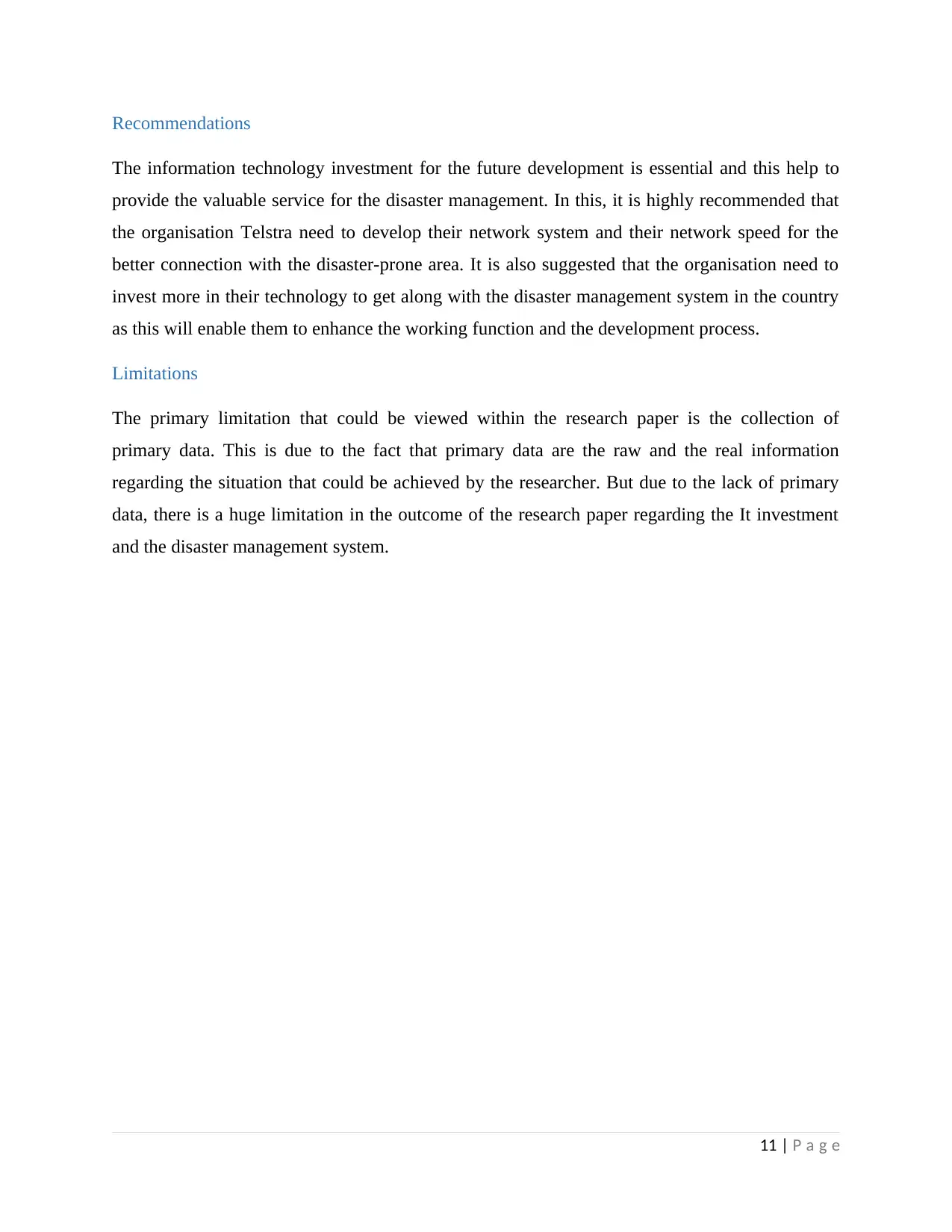
Recommendations
The information technology investment for the future development is essential and this help to
provide the valuable service for the disaster management. In this, it is highly recommended that
the organisation Telstra need to develop their network system and their network speed for the
better connection with the disaster-prone area. It is also suggested that the organisation need to
invest more in their technology to get along with the disaster management system in the country
as this will enable them to enhance the working function and the development process.
Limitations
The primary limitation that could be viewed within the research paper is the collection of
primary data. This is due to the fact that primary data are the raw and the real information
regarding the situation that could be achieved by the researcher. But due to the lack of primary
data, there is a huge limitation in the outcome of the research paper regarding the It investment
and the disaster management system.
11 | P a g e
The information technology investment for the future development is essential and this help to
provide the valuable service for the disaster management. In this, it is highly recommended that
the organisation Telstra need to develop their network system and their network speed for the
better connection with the disaster-prone area. It is also suggested that the organisation need to
invest more in their technology to get along with the disaster management system in the country
as this will enable them to enhance the working function and the development process.
Limitations
The primary limitation that could be viewed within the research paper is the collection of
primary data. This is due to the fact that primary data are the raw and the real information
regarding the situation that could be achieved by the researcher. But due to the lack of primary
data, there is a huge limitation in the outcome of the research paper regarding the It investment
and the disaster management system.
11 | P a g e
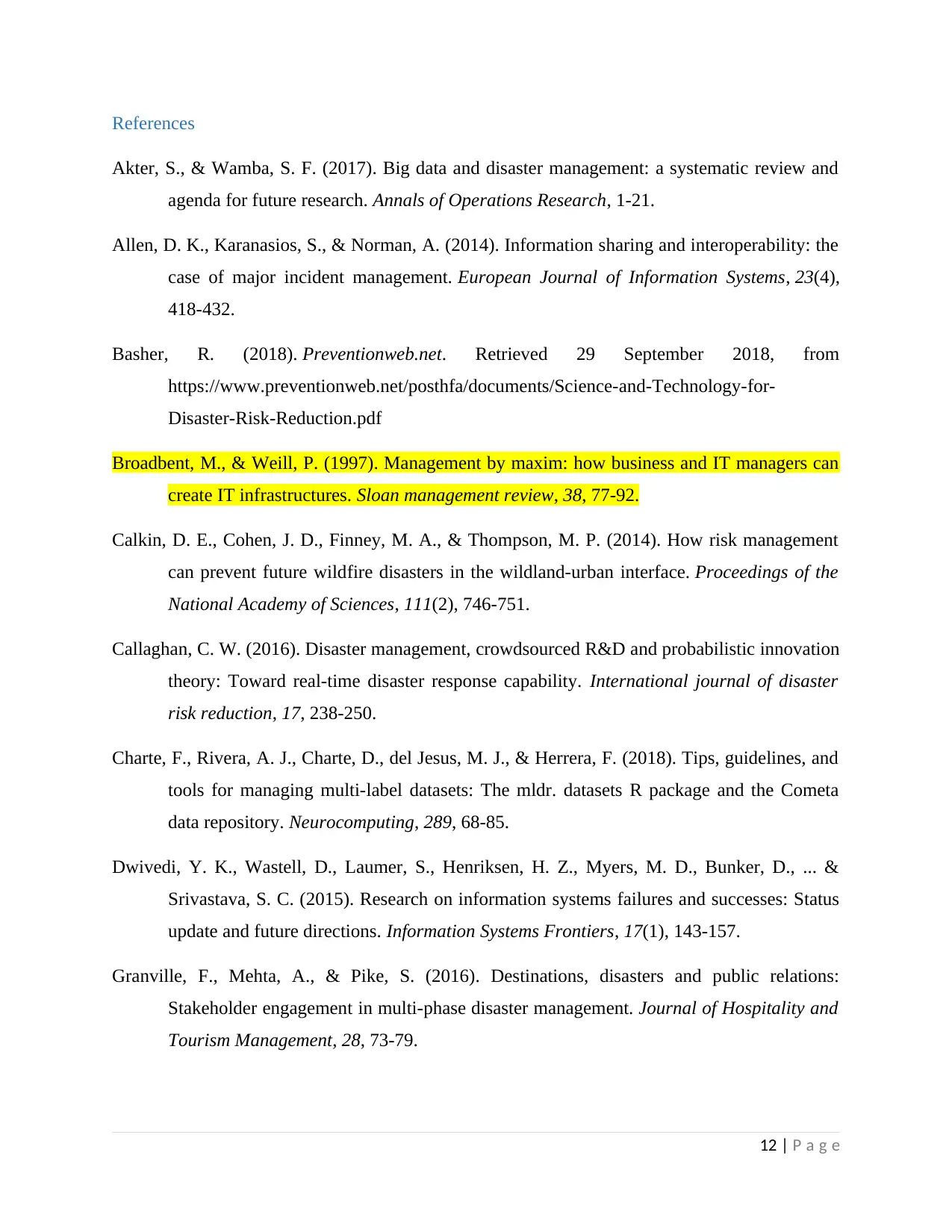
References
Akter, S., & Wamba, S. F. (2017). Big data and disaster management: a systematic review and
agenda for future research. Annals of Operations Research, 1-21.
Allen, D. K., Karanasios, S., & Norman, A. (2014). Information sharing and interoperability: the
case of major incident management. European Journal of Information Systems, 23(4),
418-432.
Basher, R. (2018). Preventionweb.net. Retrieved 29 September 2018, from
https://www.preventionweb.net/posthfa/documents/Science-and-Technology-for-
Disaster-Risk-Reduction.pdf
Broadbent, M., & Weill, P. (1997). Management by maxim: how business and IT managers can
create IT infrastructures. Sloan management review, 38, 77-92.
Calkin, D. E., Cohen, J. D., Finney, M. A., & Thompson, M. P. (2014). How risk management
can prevent future wildfire disasters in the wildland-urban interface. Proceedings of the
National Academy of Sciences, 111(2), 746-751.
Callaghan, C. W. (2016). Disaster management, crowdsourced R&D and probabilistic innovation
theory: Toward real-time disaster response capability. International journal of disaster
risk reduction, 17, 238-250.
Charte, F., Rivera, A. J., Charte, D., del Jesus, M. J., & Herrera, F. (2018). Tips, guidelines, and
tools for managing multi-label datasets: The mldr. datasets R package and the Cometa
data repository. Neurocomputing, 289, 68-85.
Dwivedi, Y. K., Wastell, D., Laumer, S., Henriksen, H. Z., Myers, M. D., Bunker, D., ... &
Srivastava, S. C. (2015). Research on information systems failures and successes: Status
update and future directions. Information Systems Frontiers, 17(1), 143-157.
Granville, F., Mehta, A., & Pike, S. (2016). Destinations, disasters and public relations:
Stakeholder engagement in multi-phase disaster management. Journal of Hospitality and
Tourism Management, 28, 73-79.
12 | P a g e
Akter, S., & Wamba, S. F. (2017). Big data and disaster management: a systematic review and
agenda for future research. Annals of Operations Research, 1-21.
Allen, D. K., Karanasios, S., & Norman, A. (2014). Information sharing and interoperability: the
case of major incident management. European Journal of Information Systems, 23(4),
418-432.
Basher, R. (2018). Preventionweb.net. Retrieved 29 September 2018, from
https://www.preventionweb.net/posthfa/documents/Science-and-Technology-for-
Disaster-Risk-Reduction.pdf
Broadbent, M., & Weill, P. (1997). Management by maxim: how business and IT managers can
create IT infrastructures. Sloan management review, 38, 77-92.
Calkin, D. E., Cohen, J. D., Finney, M. A., & Thompson, M. P. (2014). How risk management
can prevent future wildfire disasters in the wildland-urban interface. Proceedings of the
National Academy of Sciences, 111(2), 746-751.
Callaghan, C. W. (2016). Disaster management, crowdsourced R&D and probabilistic innovation
theory: Toward real-time disaster response capability. International journal of disaster
risk reduction, 17, 238-250.
Charte, F., Rivera, A. J., Charte, D., del Jesus, M. J., & Herrera, F. (2018). Tips, guidelines, and
tools for managing multi-label datasets: The mldr. datasets R package and the Cometa
data repository. Neurocomputing, 289, 68-85.
Dwivedi, Y. K., Wastell, D., Laumer, S., Henriksen, H. Z., Myers, M. D., Bunker, D., ... &
Srivastava, S. C. (2015). Research on information systems failures and successes: Status
update and future directions. Information Systems Frontiers, 17(1), 143-157.
Granville, F., Mehta, A., & Pike, S. (2016). Destinations, disasters and public relations:
Stakeholder engagement in multi-phase disaster management. Journal of Hospitality and
Tourism Management, 28, 73-79.
12 | P a g e
Paraphrase This Document
Need a fresh take? Get an instant paraphrase of this document with our AI Paraphraser
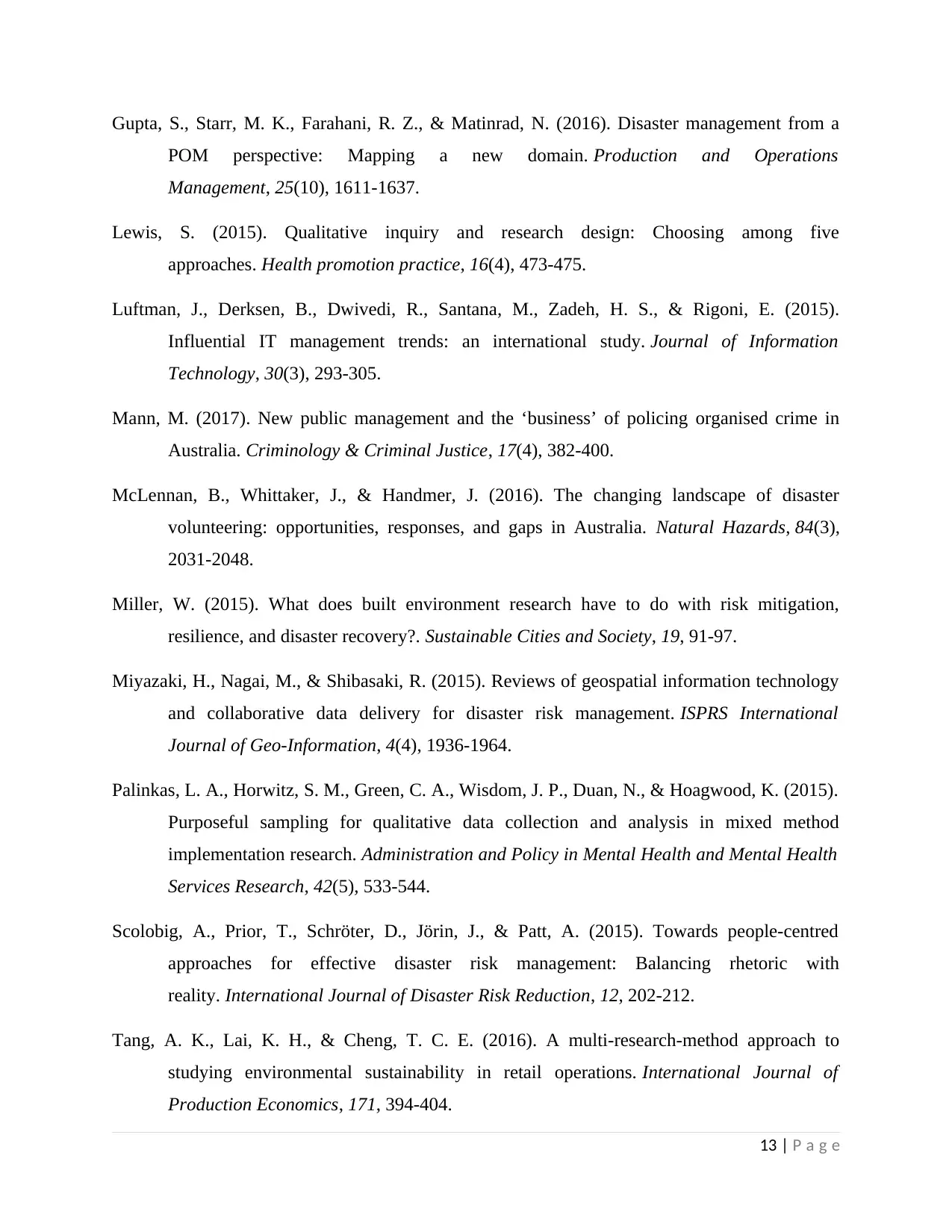
Gupta, S., Starr, M. K., Farahani, R. Z., & Matinrad, N. (2016). Disaster management from a
POM perspective: Mapping a new domain. Production and Operations
Management, 25(10), 1611-1637.
Lewis, S. (2015). Qualitative inquiry and research design: Choosing among five
approaches. Health promotion practice, 16(4), 473-475.
Luftman, J., Derksen, B., Dwivedi, R., Santana, M., Zadeh, H. S., & Rigoni, E. (2015).
Influential IT management trends: an international study. Journal of Information
Technology, 30(3), 293-305.
Mann, M. (2017). New public management and the ‘business’ of policing organised crime in
Australia. Criminology & Criminal Justice, 17(4), 382-400.
McLennan, B., Whittaker, J., & Handmer, J. (2016). The changing landscape of disaster
volunteering: opportunities, responses, and gaps in Australia. Natural Hazards, 84(3),
2031-2048.
Miller, W. (2015). What does built environment research have to do with risk mitigation,
resilience, and disaster recovery?. Sustainable Cities and Society, 19, 91-97.
Miyazaki, H., Nagai, M., & Shibasaki, R. (2015). Reviews of geospatial information technology
and collaborative data delivery for disaster risk management. ISPRS International
Journal of Geo-Information, 4(4), 1936-1964.
Palinkas, L. A., Horwitz, S. M., Green, C. A., Wisdom, J. P., Duan, N., & Hoagwood, K. (2015).
Purposeful sampling for qualitative data collection and analysis in mixed method
implementation research. Administration and Policy in Mental Health and Mental Health
Services Research, 42(5), 533-544.
Scolobig, A., Prior, T., Schröter, D., Jörin, J., & Patt, A. (2015). Towards people-centred
approaches for effective disaster risk management: Balancing rhetoric with
reality. International Journal of Disaster Risk Reduction, 12, 202-212.
Tang, A. K., Lai, K. H., & Cheng, T. C. E. (2016). A multi-research-method approach to
studying environmental sustainability in retail operations. International Journal of
Production Economics, 171, 394-404.
13 | P a g e
POM perspective: Mapping a new domain. Production and Operations
Management, 25(10), 1611-1637.
Lewis, S. (2015). Qualitative inquiry and research design: Choosing among five
approaches. Health promotion practice, 16(4), 473-475.
Luftman, J., Derksen, B., Dwivedi, R., Santana, M., Zadeh, H. S., & Rigoni, E. (2015).
Influential IT management trends: an international study. Journal of Information
Technology, 30(3), 293-305.
Mann, M. (2017). New public management and the ‘business’ of policing organised crime in
Australia. Criminology & Criminal Justice, 17(4), 382-400.
McLennan, B., Whittaker, J., & Handmer, J. (2016). The changing landscape of disaster
volunteering: opportunities, responses, and gaps in Australia. Natural Hazards, 84(3),
2031-2048.
Miller, W. (2015). What does built environment research have to do with risk mitigation,
resilience, and disaster recovery?. Sustainable Cities and Society, 19, 91-97.
Miyazaki, H., Nagai, M., & Shibasaki, R. (2015). Reviews of geospatial information technology
and collaborative data delivery for disaster risk management. ISPRS International
Journal of Geo-Information, 4(4), 1936-1964.
Palinkas, L. A., Horwitz, S. M., Green, C. A., Wisdom, J. P., Duan, N., & Hoagwood, K. (2015).
Purposeful sampling for qualitative data collection and analysis in mixed method
implementation research. Administration and Policy in Mental Health and Mental Health
Services Research, 42(5), 533-544.
Scolobig, A., Prior, T., Schröter, D., Jörin, J., & Patt, A. (2015). Towards people-centred
approaches for effective disaster risk management: Balancing rhetoric with
reality. International Journal of Disaster Risk Reduction, 12, 202-212.
Tang, A. K., Lai, K. H., & Cheng, T. C. E. (2016). A multi-research-method approach to
studying environmental sustainability in retail operations. International Journal of
Production Economics, 171, 394-404.
13 | P a g e
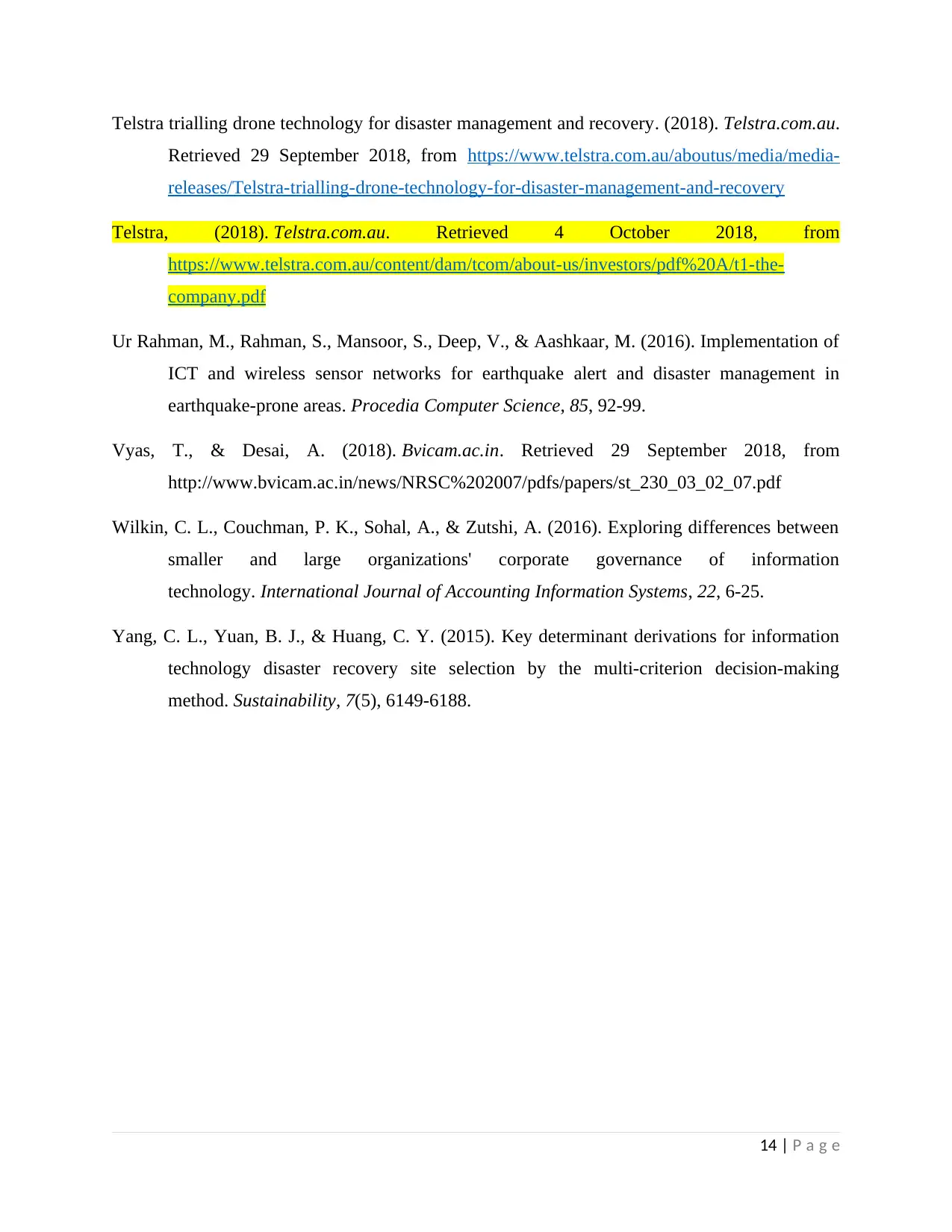
Telstra trialling drone technology for disaster management and recovery. (2018). Telstra.com.au.
Retrieved 29 September 2018, from https://www.telstra.com.au/aboutus/media/media-
releases/Telstra-trialling-drone-technology-for-disaster-management-and-recovery
Telstra, (2018). Telstra.com.au. Retrieved 4 October 2018, from
https://www.telstra.com.au/content/dam/tcom/about-us/investors/pdf%20A/t1-the-
company.pdf
Ur Rahman, M., Rahman, S., Mansoor, S., Deep, V., & Aashkaar, M. (2016). Implementation of
ICT and wireless sensor networks for earthquake alert and disaster management in
earthquake-prone areas. Procedia Computer Science, 85, 92-99.
Vyas, T., & Desai, A. (2018). Bvicam.ac.in. Retrieved 29 September 2018, from
http://www.bvicam.ac.in/news/NRSC%202007/pdfs/papers/st_230_03_02_07.pdf
Wilkin, C. L., Couchman, P. K., Sohal, A., & Zutshi, A. (2016). Exploring differences between
smaller and large organizations' corporate governance of information
technology. International Journal of Accounting Information Systems, 22, 6-25.
Yang, C. L., Yuan, B. J., & Huang, C. Y. (2015). Key determinant derivations for information
technology disaster recovery site selection by the multi-criterion decision-making
method. Sustainability, 7(5), 6149-6188.
14 | P a g e
Retrieved 29 September 2018, from https://www.telstra.com.au/aboutus/media/media-
releases/Telstra-trialling-drone-technology-for-disaster-management-and-recovery
Telstra, (2018). Telstra.com.au. Retrieved 4 October 2018, from
https://www.telstra.com.au/content/dam/tcom/about-us/investors/pdf%20A/t1-the-
company.pdf
Ur Rahman, M., Rahman, S., Mansoor, S., Deep, V., & Aashkaar, M. (2016). Implementation of
ICT and wireless sensor networks for earthquake alert and disaster management in
earthquake-prone areas. Procedia Computer Science, 85, 92-99.
Vyas, T., & Desai, A. (2018). Bvicam.ac.in. Retrieved 29 September 2018, from
http://www.bvicam.ac.in/news/NRSC%202007/pdfs/papers/st_230_03_02_07.pdf
Wilkin, C. L., Couchman, P. K., Sohal, A., & Zutshi, A. (2016). Exploring differences between
smaller and large organizations' corporate governance of information
technology. International Journal of Accounting Information Systems, 22, 6-25.
Yang, C. L., Yuan, B. J., & Huang, C. Y. (2015). Key determinant derivations for information
technology disaster recovery site selection by the multi-criterion decision-making
method. Sustainability, 7(5), 6149-6188.
14 | P a g e
1 out of 15
Related Documents
Your All-in-One AI-Powered Toolkit for Academic Success.
+13062052269
info@desklib.com
Available 24*7 on WhatsApp / Email
![[object Object]](/_next/static/media/star-bottom.7253800d.svg)
Unlock your academic potential
© 2024 | Zucol Services PVT LTD | All rights reserved.




